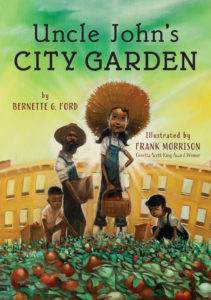

There are still a few urban gardens in the city’s housing projects that keep communities flourishing. Some who grew up in New York City Housing decades ago may have fond memories of their neighborhoods before overdevelopment and commercialization monopolized surrounding areas.
Late author Bernette G. Ford, who passed away in June 2021, was determined to highlight childhood visits to her uncle’s garden – once located on the grounds of Canarsie’s Breukelen Houses.
On May 3rd, her unique and final picture book entitled, Uncle John’s City Garden, was released and hit the shelves as a true celebration of nature, family and food.
Her wonderfully crafted children’s book – complete with colorful illustrations and a recipe for homemade succotash – explores what would have happened if she was able to keep her uncle’s garden in the Breukelen Houses flourishing.
In her author’s note, Ford writes: “This is an ‘almost’ true story. When I was a little girl in the 1950s, my Uncle John lived in the projects in Canarsie, Brooklyn. He and my mother were the youngest of seven surviving siblings born on a plantation in Louisiana where their father worked and was ‘in charge’ of other Black laborers on the plantation. Everyone eventually left the plantation as young adults. When they moved to Breukelen Houses, still being constructed at the time, my mother and uncle continued growing gardens full of various foods and flowers.”
“When the building of the projects ended, the huge, deep excavation for the final building was left empty,” Ford explained in the book. “Uncle John got permission from the City to grow a garden in that hole. I visited the garden often as a child but I never got to spend a whole summer working in it. I wish I could have – and now, in this story, I have.”
Ford’s friend, Joan Cummings, who grew up across the street from the Breukelen Houses where the farm flourished, had nostalgic recollections of the community.
In a media interview she said, “From the early 1960s, my family lived across the street from the farm at the Breukelen Houses projects in Canarsie. To anyone living in New York at the time – Canarsie was on the other side of the world. One block away was our train line, the BMT-LL, which ran at ground level and our station had a moving RR crossing gate for traffic and pedestrians. Much of the area near our building was undeveloped and much of it was swampy, overgrown grassy land and many of the side roads were not paved. The farm took up about half a city block. The other half was a row of simple private homes. We lived on the seventh floor in the front of our building so I could see down into the farm from our kitchen window. The farm was down an incline, or a gully, which also helped to keep it very private. There was a structure/shack in the middle of the farm and the crops grew all around. Beyond corn, I couldn’t tell what was growing but it always looked like a bumper crop. I’d look down from our apartment and see a bit of activity on the farm through the growing crops.”
In the book, Ford’s character, Li’l Sissy, may be younger than her brother and sister, but that doesn’t stop her from helping in Uncle John’s garden – planting seeds, picking weeds and weathering thunderstorms. The siblings have to work hard if they want to enjoy fresh succotash at the big end-of-summer family barbecue.
The story is a loving glimpse at a girl, her siblings, and her uncle, and their shared passion for farming. Li’l Sissy’s fascination with measurement, comparison and estimation introduces children to STEM concepts. And the progress of Uncle John’s garden introduces readers to the life cycle of plants.
Illustrator Frank Morrison, who depicts dramatic cityscapes as well as the luscious colors and textures of nature, brings the urban story to life. A winner of multiple Coretta Scott King awards and an NAACP Image Award, the two came together to capture the wonder and satisfaction of sharing your own harvest. As a tribute to Ford, Morrison added an illustration of the author in the book’s cookout scene.
Ford is also the co-author of the groundbreaking bestseller, Bright Eyes, Brown Skin. She is also the author of bestselling Ballet Kitty series, No More Diapers For Ducky.
A publishing pioneer, she was the first African-American vice president of children’s books at a major publisher.

